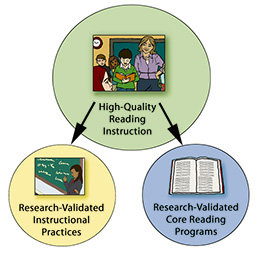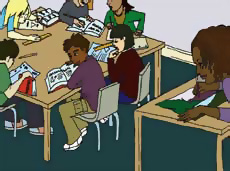How can teachers increase student reading success in early grades?
Page 2: High-Quality Instruction: Instructional Practices
 Teachers can increase students’ reading success in early grades by implementing high-quality instruction. High-quality instruction refers to the utilization of both research-validated instructional practices and core reading programs. Implementing high-quality instruction allows teachers to rule out inadequate instruction as a reason for poor reading performance.
Teachers can increase students’ reading success in early grades by implementing high-quality instruction. High-quality instruction refers to the utilization of both research-validated instructional practices and core reading programs. Implementing high-quality instruction allows teachers to rule out inadequate instruction as a reason for poor reading performance.
Information about core reading programs can be found on the following page. The remainder of this page will discuss instructional practices.
Instructional Practices
Scientifically based instructional practices are those that instructors use to teach content and that have been demonstrated to be effective. Though there are many such practices, this module will focus on two: differentiated instruction and grouping.
Differentiated Instruction
 Differentiated instruction refers to the use of flexible teaching approaches in the classroom to accommodate the individual learning needs of all students. Rather than expect students to adjust to the curriculum, teachers should adjust the curriculum to fit the diverse learning needs of their students. By using students’ assessment data, teachers can alter instruction to maximize all students’ learning, including that of gifted and talented students. These data allow teachers to quickly recognize problematic areas and to adjust the instructional approach to resolve them. When using differentiated instruction, teachers also analyze errors, give corrective feedback, and select examples related to students’ backgrounds or experiences to illustrate concepts.
Differentiated instruction refers to the use of flexible teaching approaches in the classroom to accommodate the individual learning needs of all students. Rather than expect students to adjust to the curriculum, teachers should adjust the curriculum to fit the diverse learning needs of their students. By using students’ assessment data, teachers can alter instruction to maximize all students’ learning, including that of gifted and talented students. These data allow teachers to quickly recognize problematic areas and to adjust the instructional approach to resolve them. When using differentiated instruction, teachers also analyze errors, give corrective feedback, and select examples related to students’ backgrounds or experiences to illustrate concepts.
Ideally, teachers should practice differentiating instruction so they can automatically adjust instruction as needed, even on a minute-to-minute basis, and thereby maximize every student’s potential.
Click to hear Thea Woodruff talk about one way to use immediate corrective feedback with students (time: 1:05).
Thea Woodruff, PhD
Director, Professional Development and Technical Assistance Teams,
Vaughn Gross Center’s Reading First Project
University of Texas, Austin

Transcript: Thea Woodruff, PhD
Corrective feedback is a more umbrella term under which “error correction” or “error-correction procedures” falls. Corrective feedback is any kind of feedback that a teacher gives to a student to show them their errors and allow them to re-practice some skill correctly.
Error correction procedures, on the other hand, are those that the teacher or maybe another student—in, say, peer tutoring or in partner work—uses to provide corrective feedback to another student. Usually there is specific error-correction procedure that a teacher or a student would use given a specific task or activity. For example, during partner reading, when one student (say, Partner 1) is practicing reading a text aloud and he misreads a word, the other student (Partner 2) says, “Stop, that word is ‘sometimes,’ ” pointing to the word “sometimes”; Asks, “What word?”; Partner 1 then repeats the word, says “sometimes”; and then Partner 2 directs Partner 1 back to the beginning of the sentence to reread the sentence aloud with the correct word, “sometimes,” in it.
Keep in Mind
Differentiated instruction is most effective when used in combination with different types of grouping. For example, it is more difficult to provide ample practice opportunities and immediate corrective feedback for a class of 21 students than it is to do so for a small group of five.
Grouping
 Although differentiated instruction can be implemented during whole-group instruction, it is more effective when teachers use flexible grouping practices. This helps engage students and facilitates the acquisition of literacy skills. In addition to whole-group instruction, teachers can use a combination of:
Although differentiated instruction can be implemented during whole-group instruction, it is more effective when teachers use flexible grouping practices. This helps engage students and facilitates the acquisition of literacy skills. In addition to whole-group instruction, teachers can use a combination of:
- Small groups (both of same ability and of mixed ability)
- Paired instruction
- Independent work
- One-on-one instruction (if needed and possible)
Although many teachers believe that whole-group lessons are the best way to deliver reading instruction, research indicates that flexible grouping improves learning.
Research Shows
- Reading outcomes for students with disabilities improved when teachers used small-group instruction rather than whole-class instruction.
(Elbaum, Vaughn, Hughes, Watson, & Moody, 1999) - Reading fluency and comprehension outcomes improved when teachers implemented paired instruction in the classroom, regardless of students’ disabilities or achievement levels.
(Fuchs & Fuchs, 2005)
Flexible grouping, however, is more difficult to implement because of the many adaptations to instruction and materials that are often necessary. Here are some suggestions for grouping students.
| Educational Needs |
|
| Interests |
|